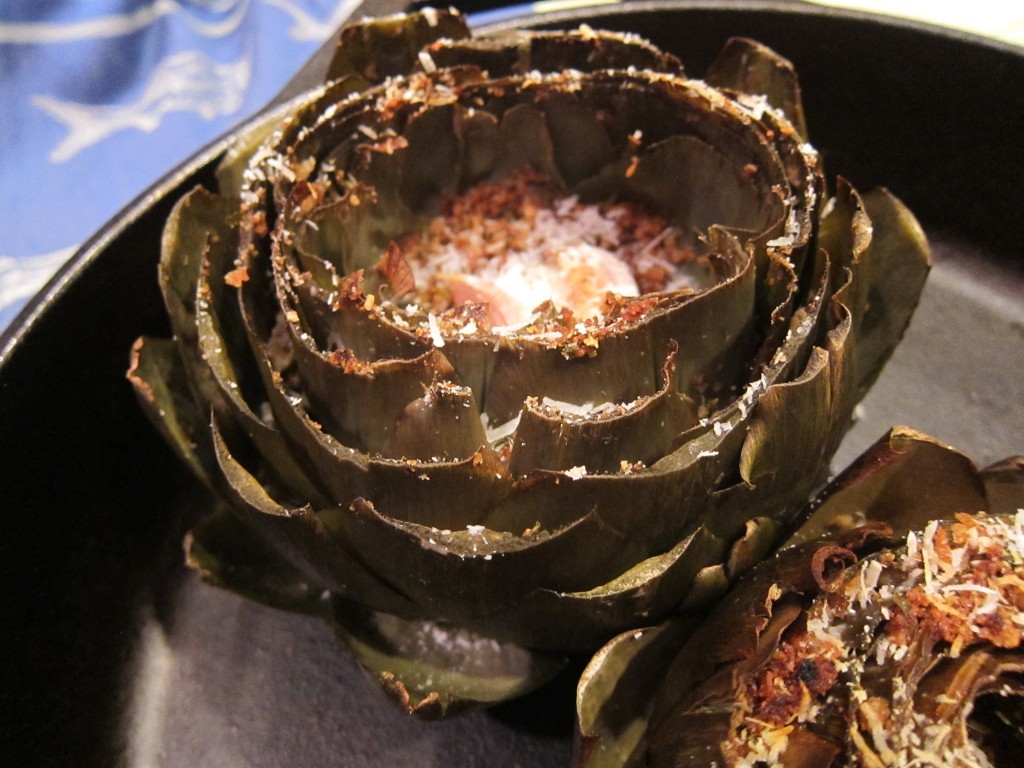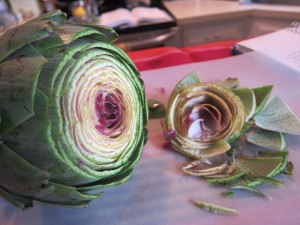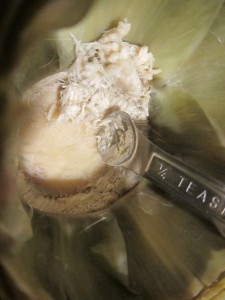 My mission this week: to make artichokes a little less intimidating. I wish I could tell you I came away from this exercise with some technique that will magically transform these mysterious globes into a fast, after-work kind of dish.
My mission this week: to make artichokes a little less intimidating. I wish I could tell you I came away from this exercise with some technique that will magically transform these mysterious globes into a fast, after-work kind of dish.
Sorry, gang — that’s not going to happen.
But I was able to test and compare some techniques so you won’t have to. And while I tried only one rather classic preparation — artichokes stuffed with seasoned breadcrumbs — perhaps I’ll demystify these little monsters enough that you can stop giving them a wide berth. Because, while they are a fair amount of effort, they’re well worth the time, if you’ve got it.
The Tastiest Thistle
First, the basics. Artichokes are thistles (it’s true!), with a delicious but well-hidden heart, protected by a fuzzy, inedible “choke.” The delectable hearts are surrounded by leaves of varying tenderness (you’ll find a handy diagram here).
The inner leaves are tender and easy to eat, but become increasingly tough toward the outside of the plant. Only the bottom portion of those tougher outer leaves is soft and edible; that’s the part you scrape against your teeth.
If that seems like a lot of “inedibles,” it is. Most of an artichoke simply can’t be eaten. Accept that you’re going to throw a lot away (not easy for someone who hates wasting food). What you do get to eat is very tasty.
While there is a dizzying array of artichokes available in Europe, you’ll likely see only a few varieties here, known as “globe artichokes.” They also vary widely in size, from the size of a naval orange to a large grapefruit.* Naturally, the larger the artichoke, the longer it takes to cook. Depending on size and how you prepare them (cutting them in half, for example, is much faster than cooking them whole), cooking time can vary from 20 minutes to an hour or more.
If You’re Feeling Artichoke-y …
I only scratch the surface here, but there are some good resources out there for the intrigued. For sheer amazement — and some great-looking recipes — check out theartichokeblog.com. Michael’s been researching artichokes for several years in Italy, where the prickly things are seemingly ubiquitous. The gorgeous varieties and preparations on the blog will blow your mind (Michael’s even stumbled upon artichoke gelato).
Also, Jacques Pepin, my culinary hero, is a master of all things, including the artichoke. I stick with whole artichokes with this post, but he’ll teach an entirely different prep method — paring a raw artichoke down to the heart, leaving the leaves behind — here.

The Easiest Way
The many ways to cook an artichoke might leave you dizzy. You can steam them whole in a pot or in the oven. You can slice them in half before steaming or roasting them. You can pare them down to their tender hearts.
As promised, I’ll offer up one take — a classic stuffed artichoke — below. But first, I’ll digress a moment to share what may be the simplest way to prepare an artichoke — my mom’s method: boiled whole, then set in a bowl, to be plucked, leaf by tasty leaf.
Simply cut off the entire stem (so the base will sit flat in your dish), slice off the artichoke’s top, snip the remaining pointy leaf ends with scissors, and boil it in water until you can easily spear it with a knife.
Remove from the water and drain upside down. When you’re ready to eat, pluck the leaves, one by one, and dip in the flavored butter, mayonnaise or aioli of your choice. Eventually, you’ll reveal the tiny tender leaves at the core (these, unlike the outer leaves, are almost entirely edible). Then, scrape away the fuzzy choke and enjoy the delicious heart you’ve worked so hard for. (See the “Etiquette of Eating Artichokes” section here for more tips).
Whole Stuffed Artichokes, Step One: Trimming Now, on to the show! Whole stuffed artichokes, trimmed, prepped and then steamed in the oven. You’ll find the detailed recipe below, but first, we’ll go through some basic techniques.
You’ll need to trim your artichoke to make it easy to work with. For this preparation, you want the artichoke to sit on its base in your dish, so begin by cutting off the entire stem. Then, slice off the artichoke’s top inch or so with a sharp knife, and snip off the pointy leaf ends with scissors. I won’t reinvent the wheel here — this Saveur slideshow breaks it down nicely.
Also, don’t toss out the stems! They’re tender and delicious, as long as you peel the thick outer skin before cooking them.
Step Two: Removing The Choke

Most stuffed artichoke recipes use one of two techniques to remove the fuzzy choke before stuffing.
Method one: Some recipes direct you to remove the center leaves and scrape out the choke while the vegetable is raw, then stuff and steam.
Method two: Others recommend boiling the whole artichoke until just tender (about 20 to 30 minutes), then removing the center leaves and choke before stuffing.
The first method sounded faster and simpler, but my hero Jacques Pepin recommends the latter. So I compared both techniques above, to save you the trouble.
My verdict: Never doubt the master. Jacques knows what’s up. He wasn’t Charles de Gaulle’s personal chef for nothing. Yes, you can scrape the choke out of a raw artichoke (method one), but removing enough of the center leaves (very firm when raw) to fully expose it is a lot harder than it sounds. And fully removing the choke is virtually impossible without a very sharp-edged spoon (I read a grapefruit spoon helps). I never was able to do the job fully.
On the other hand, boiling the entire artichoke ahead of time (method two), as Jacques recommends, made removing the choke and surrounding leaves a snap. Also, while I had expected method one would save time overall, by skipping the boiling step, it didn’t. Compared to the pre-boiled artichoke, my “method one” artichoke took twice as long to finish cooking in the oven, and was never as tender as its pre-boiled counterpart.
The Final Steps: Stuff And Bake!
One other benefit of the pre-boiling method: you can prepare your bread crumb stuffing while the artichokes are in the pot. Since this step, and those that follow (stuffing and baking), are pretty straightforward, I’ll wrap things up here and refer you to the recipe below.
So, our intrepid eaters, fear not the artichoke! They take some prep, but you can slay these spiky beasts. You’ll be glad you did — they’re well worth the effort.
*You can also find baby artichokes, which are quite wee. These are nice, because they cook up quickly and don’t have the fuzzy choke — meaning you can eat almost the entire thing (with a loss let work!).
Oven-Steamed Stuffed Artichokes
Note about prepping the artichokes: When the artichokes are par-boiled, the center leaves and choke can be removed far more easily than trying to remove them raw. It also yields a more tender finished artichoke.
2 large artichokes (or 3 medium ones)
1 tablespoon butter
2 tablespoons olive oil
1 shallot
2-3 garlic cloves
1 cup breadcrumbs
1/4 cup grated parmesan or other hard cheese
1-2 tablespoons parsley, chopped
1-2 teaspoons herbs of your choice (thyme, oregano, etc.)
salt and pepper to tastePrepare artichokes for stuffing: Cut the stems off the bottom of the artichokes (so they can sit flat in the pan later) and reserve. Slice off the top inch or so with a sharp knife, and snip the remaining sharp leaf tips off with scissors. Bring a large pot of water to boil and add the artichokes, using a plate or bowl to keep them submerged. Lower the heat to a gentle boil for about 30 minutes. Drain and rinse with cold water, then rinse again.
When they’re cool, gently spread apart the artichoke and pull out the center cone of leaves. It should come out all in one piece. Then gently scrape the center inside down to the smooth choke. If you see symmetrical small dots, you’re not done — keep scraping, but be gentle so as not to cut into the choke. You want the inside bottom to be smooth, not dotted or bumpy. You need a pretty sharp spoon for this, like the edge of a thin metal measuring spoon, or a grapefruit spoon.
Prepare stuffing: Heat butter and oil in skillet on medium-high. Add the shallot, garlic, bread crumbs, herbs (but not the parsley), salt and pepper, and cook for about five minutes until they’re mixed and browned, stirring regularly to prevent burning. Remove from heat and stir in parsley and grated cheese.
Stuff artichokes: Spoon about a tablespoon or two of stuffing into the center cavity, and then gently spread apart the leaves and spoon about a teaspoon or so of stuffing between each leaf. Drizzle each artichoke with two or three tablespoons of olive oil, sprinkle with remaining grated cheese, and set in an appropriately-sized baking dish.
Cook stuffed artichokes: Pour one cup of water into the dish, cover tightly with foil, and bake in a 400-degree oven until a leaf can be pulled out easily, and/or you can easily pierce the artichoke base with a knife (this can take anywhere from 40 minutes to an hour and 15 minutes, depending on the artichokes’ size.




[…] had miraculously acquired a new coat of steel. After a few minutes on the grill with some lovely artichokes, it’s to the table for Lobster Part […]